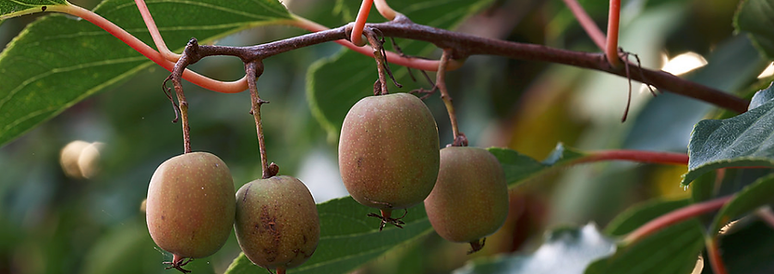

Newsletters
Am I allowed to use the login credentials of
another person to access the database?
Alligatorweed
(Alternanthera philoxeroides)
Found an invasive species? Register for a free login account, or submit a public report.

Photo credit: © Mauritius Vecchia Pinxit A.D. MMXIV
Hardy Kiwi Vine
(Actinidia arguta)
Report this Species!
If you believe you have found this species anywhere in Pennsylvania, please report your findings to iMapInvasives by submitting an observation record.
-
Already a registered user? Login to submit your observation.
-
Not a registered user? Submit a public report.
-
Watch our training video to learn how to submit an observation record (as a registered user).
Species at a Glance
Hardy kiwi is a twining, woody vine with alternate, simple leaves. Its leaves have distinctive red petioles and finely-toothed, wavy margins. Flowers are pale green/white and clustered in the leaf axils, while the fruits are green, grape-shaped, and smooth.
Similar Species
Hardy kiwi vine can be confused with other species of Actinidia, including the most familiar, the fuzzy kiwifruit (Actinidia deliciosa).
Habitat
Hardy kiwi vine is a terrestrial species, found in forests, shrublands, meadows, and cultivated in landscaped settings.
Spread
Fruits are eaten by raccoons. Other mammals, and possibly large birds such as wild turkey and ruffed grouse are also expected to consume the fruits and disperse the seeds.
Distribution
Native to northeast Asia, hardy kiwi vine was introduced into North America from cuttings in 1886 (for use as a horticultural plant). Cultivars were selected for fruit characteristics and have recently become popular. In this region, hardy kiwi vine has been reported in Ontario, Maine, Massachusetts, New Jersey, Ohio, and Pennsylvania. In Pennsylvania, hardy kiwi vine has only been found in Philadelphia County.
Environmental Impacts
Hardy kiwi vine forms dense mats of intertwining vines that can severely overwhelm other vegetation, including trees. In winter, tree trunks and branches supporting hardy kiwi vines will break under excess weight caused by snow and ice. This species can tolerate cold temperatures (-25° F or lower) and is able to grow 20 feet or more per year.
Note
Information for this species profile comes from various sources including: